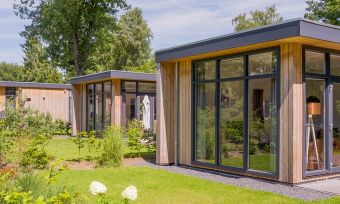What does it cost to build a granny flat?
Granny flats can be a cute and versatile addition to your property. But their small scale doesn’t always mean granny flats come with a pint-sized cost.

Granny flats can be a cute and versatile addition to your property. But their small scale doesn’t always mean granny flats come with a pint-sized cost.
Granny flats: the new Aussie dream?
The humble granny flat serves many purposes: a guest house, a retreat for teens, a living space for relatives, and even a source of rental income. It seems the granny flat may even have replaced the pool as the must-have back yard feature. A recent Housing Industry Association (HIA) survey showed that granny flat construction has ken off in recent years, with Aussie builders estimating they’ve seen a tenfold increase in demand in recent years.
If you’re considering adding a granny flat to your property, whether to earn rental income or provide extra living space for your family, cost is likely at the front of your mind. The price of construction isn’t exactly getting lower, so how much will a granny flat set you back, and how much value will it realistically add to your home?
How much does it cost to build a granny flat?
The cost of a granny flat can vary substantially depending on whether you choose to do it yourself or engage professionals.
DIY granny flat: $30,000+
You may be able to find 1-bedroom granny flat kits to build yourself for less than $30,000. However, this may not include all the costs for completion, such as footings for the building, electrical wiring and plumbing. If you plan on renting a granny flat out, it will need to comply with your local residential tenancy laws, so if you plan on a DIY build, you may risk falling afoul of these.It’s important to read the fine print to know exactly what you’re buying, and any additional costs you could face before your granny flat is ready to move into.
Professionally-built granny flat: $80,000 – $160,000+
According to trades website HiPages, a granny flat can cost $80,000 – $160,000, depending on size and design. However, high-spec custom builds can easily cost over $200,000. Also, check what contract you will be signing, such as a ‘cost-plus’ contract or a ‘fixed-price’ (‘lump sum’) contract. Whether you engage a local builder or a company that specialises in granny flats for your new build, think about getting several quotes, and make sure you are comparing them based on the same inclusions to get a true picture of the final cost.
Can you rent out a granny flat in Australia?
If you’re thinking about adding a granny flat or ‘secondary home’ for additional rental income, you may be wondering if you’re allowed to do so in your state or territory. At present, you are allowed to rent out a granny flat in all parts of Australia, as long as you comply with relevant local planning and tenancy laws.
Because state governments and local councils may make fresh changes and updates to laws and regulations around building and utilising granny flats, it’s always important to check with the relevant authorities before building or renting out a granny flat on your property.
What are the benefits of a granny flat?
- Family accommodation: As the name implies, a granny flat can be a private space for an older relative to live while staying close to their family.
- Rental income: By renting your granny flat out to tenants, either as long-term accommodation or short-term accommodation, you may be able to make returns on the property to benefit your finances and budget.
- Potentially increase your property value: Whether you’re thinking of selling in the future, or accessing equity in your property, a granny flat could help enhance your property’s appeal and in turn increase its overall value.
What are the downsides of granny flats?
- Upfront costs: Adding a granny flat to your home can involve paying some significant upfront cost, from the cost of parts and labour to fees, charges and more
- Council approval: Depending on the size of your property, how you plan to use the secondary dwelling and more, you may need to apply with you local council and/or state government to arrange for a granny flat to be legally built.
- Sacrificing space in your yard: A secondary dwelling will take up space on your property that could be used for other purposes, or simply left for your family’s recreation.
- Effects on your taxes: Renting out a granny flat comes with similar responsibilities and complications as owning any other investment property, including having to declare rental income on your taxes.
- Potential CGT if you sell: Raising the value of your property by adding a granny flat can mean having to pay Capital Gains Tax (CGT) if you sell the property in the future, though there are some circumstances where CGT may not apply for a granny flat.
How can you finance a granny flat?
- Draw on your savings: If you have the funds available in a savings account:, then self-funding a construction job means you can avoid taking out a loan.
- Use your existing offset or redraw facility:If you’ve previously made extra repayments on your home loan, or deposited savings into an offset account, you may have the option to make a redraw on your home loan or use your offset funds to pay for a granny flat.
- Refinance your home loan:If you have sufficient equity in your home you may be able to top up your home loan or refinance the mortgage to borrow enough to pay for a granny flat.
- Consider a personal loan: A secured or unsecured personal loan could help you finance a granny flat, but be aware that personal loan interest rates are generally higher than for home loans.
Can I put a granny flat on my property?
A good starting point is to contact your local council regarding the rules in your area. Consider the following:
- the size of your block (a minimum lot size of 450 square metres is often required);
- how far the granny flat is from the boundary and the existing house;
- the availability of a separate entrance, and;
- the dimensions of the granny flat.
Do I need council approval to build a granny flat?
Whether you need council approval to build a granny flat typically depends on the rules in your area. In many cases you will need to apply for council approval, but in some areas you may not need approval as long as you meet certain criteria.
The rules around granny flats can vary significantly from one state and one local council area to another, and there may be specific rules about the size of the structure you can build, how much space is needed on the block and how many structures can be built. For this reason, it’s advisable to do your research carefully, get in touch with your local council and find out exactly what permits you’ll need and what you’re allowed to build before embarking on any construction projects.
A professional builder in your area may also be able to answer your questions about the requirements to build a granny flat.
Will a granny flat increase the value of my home?
A granny flat that is well-constructed and compliant with council regulations has the potential to add value to a property. But they won’t appeal to every buyer. Not every household will need a granny flat, and some buyers may prefer more backyard space over a secondary dwelling.
Talking to local real estate agents could help to give you a better idea of how a granny flat could affect your property’s value. If there’s a strong demand for granny flats in your area, adding one to your property could help to enhance its value. But if there’s a granny flat oversupply, or if the area’s buyers typically have other priorities in mind, then a granny flat may not be the best investment for you.
In some cases, the cost of building a granny flat could be higher than the value it adds to your property. Overcapitalising like this could put you at risk of ending up in more debt than you can comfortably afford to repay.
What to know about Capital Gains Tax and Granny flats
There can be tax implications involved with granny flats. However, from 1 July, 2021, the Australian Tax Office (ATO) says capital gains tax may not apply if you build a granny flat for an older person or someone with special needs, as long as you have a formal written agreement in place. As tax matters can be complex, it could be a good idea to seek professional advice before building a granny flat.
Do you need to provide extra parking for a granny flat?
It is not usually a requirement that a property owner provides additional parking spaces for a granny flat. However, if you are able to add an extra parking space, this could help to attract tenants, add further value to the property, or simply allow your relative easier access
This article was reviewed by our Deputy Finance Editor Alasdair Duncan before it was updated, as part of our fact-checking process.

Mark has been a journalist and writer in the financial space for over ten years, previously researching and writing commercial real estate at CoreLogic. In the years since, Mark has worked for the Winning Group, Expedia, and has seen articles published at Lifehacker and Business Insider.
Mark has also completed RG 146 (Tier 1), making him compliant to provide general advice for general insurance products like car, home, travel and health insurance, as well as giving him knowledge of investment options such as shares, derivatives, futures, managed investments, currencies and commodities. Find Mark on Linkedin.
- Granny flats: the new Aussie dream?
- How much does it cost to build a granny flat?
- Can you rent out a granny flat in Australia?
- What are the benefits of a granny flat?
- What are the downsides of granny flats?
- How can you finance a granny flat?
- Can I put a granny flat on my property?
- Do I need council approval to build a granny flat?
- Will a granny flat increase the value of my home?
- What to know about Capital Gains Tax and Granny flats
- Do you need to provide extra parking for a granny flat?
The comparison rate for all home loans and loans secured against real property are based on secured credit of $150,000 and a term of 25 years.
^WARNING: This comparison rate is true only for the examples given and may not include all fees and charges. Different terms, fees or other loan amounts might result in a different comparison rate.
 Owner occupied
Owner occupied
 30% min deposit
30% min deposit
 Redraw facility
Redraw facility
Try our Home Loans comparison tool to instantly compare Canstar expert rated options.





